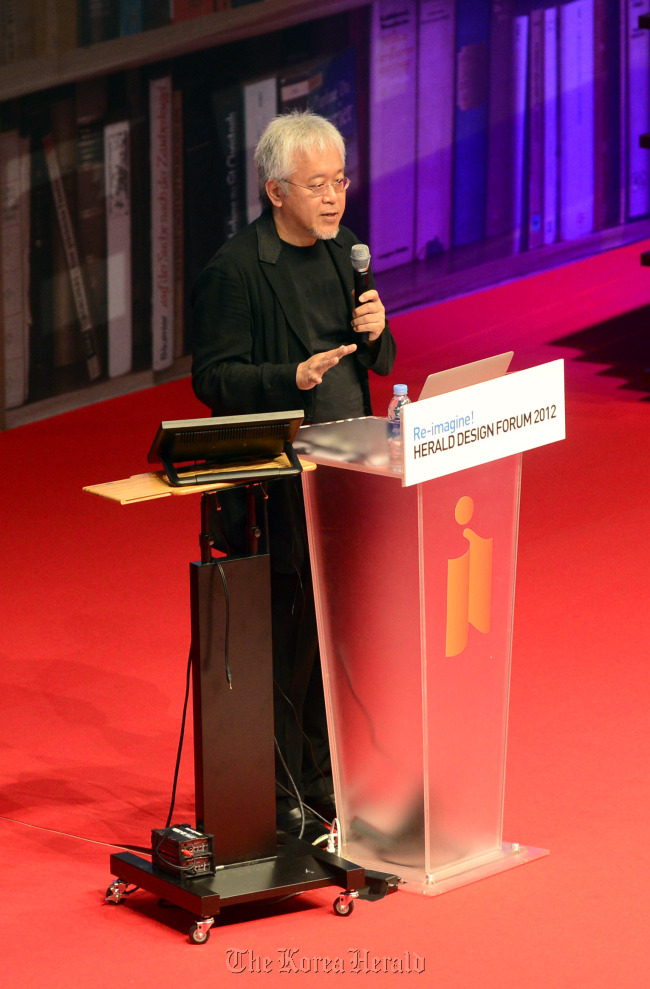
Many would think of the products of Japanese retail company such as its blank notepads and white tea cups, as simple and minimalistic.
But the company’s art director Kenya Hara says the philosophy behind its products is “emptiness,” not “simplicity.” And it’s that “emptiness” that creates room for creativity and imagination, the designer said.
“It’s very important to talk about the concept of emptiness when I talk about Muji products,” Hara said during his lecture at the Herald Design Forum in Seoul, Thursday.
“Our products are not ‘simple.’ In the West, the concept of simplicity has become popular as it worked well with the modern development of technology, industrialization as well as the concept of practicality.
“But our products don’t necessarily reflect that,” he continued.
“They are not supposed to serve a specific purpose of a particular individual in an efficient, practical manner. Instead of making different tables for different age groups and social classes, we make one table that would fit anyone’s lifestyle. Our table blends well with its surroundings, from a simple studio to a lavish house. It’s entirely up to the person who purchases the table to use it the way she or he wants it, regardless of who they are, what they do, and where they live.”
Such a philosophy of Muji products is based on spiritual beliefs of the ancient Japanese people, who created furniture or buildings involving empty space, in case their gods would visit and stay there, said Hara. The buildings were the products of the people’s desire to communicate with the gods; these were the earliest forms of Japan’s shrines.
The “emptiness” is also closely linked with the concept of ambiguity. “It’s like one huge, empty bowl,” Hara explained. “The bowl accepts any ideas and concepts. Our products carry that desire of communication, as well as a receptive environment which creates room for creativity.”
Hara, who also has been working on a housing project, said the role of designers is to create things that people would never imagine, and things that they’d desire instantly after being introduced to it. “There’s this marketing term called ‘needs,’ and I just hate that word,” said Hara.
“Designers don’t make things that serve people’s needs. Instead, we are supposed to make things that people did not know existed, and things that are so innovative that they’d want to buy it the minute they see it.”
Addressing the issue of the increased number of single-person households, Hara said he envisions designing residential buildings that satisfy each individual’s lifestyle and taste, while being environmentally friendly and sustainable.
“I’m sure some people want to have a grand piano in his or her studio in spite of the small size,” he said. “Some would want a bigger bathtub, while some would want a bigger space for his or her bed. I think one of our jobs as designers is to make these people, who live in single-person households, happy.”
By Claire Lee (dyc@heraldcorp.com)
But the company’s art director Kenya Hara says the philosophy behind its products is “emptiness,” not “simplicity.” And it’s that “emptiness” that creates room for creativity and imagination, the designer said.
“It’s very important to talk about the concept of emptiness when I talk about Muji products,” Hara said during his lecture at the Herald Design Forum in Seoul, Thursday.
“Our products are not ‘simple.’ In the West, the concept of simplicity has become popular as it worked well with the modern development of technology, industrialization as well as the concept of practicality.
“But our products don’t necessarily reflect that,” he continued.
“They are not supposed to serve a specific purpose of a particular individual in an efficient, practical manner. Instead of making different tables for different age groups and social classes, we make one table that would fit anyone’s lifestyle. Our table blends well with its surroundings, from a simple studio to a lavish house. It’s entirely up to the person who purchases the table to use it the way she or he wants it, regardless of who they are, what they do, and where they live.”
Such a philosophy of Muji products is based on spiritual beliefs of the ancient Japanese people, who created furniture or buildings involving empty space, in case their gods would visit and stay there, said Hara. The buildings were the products of the people’s desire to communicate with the gods; these were the earliest forms of Japan’s shrines.
The “emptiness” is also closely linked with the concept of ambiguity. “It’s like one huge, empty bowl,” Hara explained. “The bowl accepts any ideas and concepts. Our products carry that desire of communication, as well as a receptive environment which creates room for creativity.”
Hara, who also has been working on a housing project, said the role of designers is to create things that people would never imagine, and things that they’d desire instantly after being introduced to it. “There’s this marketing term called ‘needs,’ and I just hate that word,” said Hara.
“Designers don’t make things that serve people’s needs. Instead, we are supposed to make things that people did not know existed, and things that are so innovative that they’d want to buy it the minute they see it.”
Addressing the issue of the increased number of single-person households, Hara said he envisions designing residential buildings that satisfy each individual’s lifestyle and taste, while being environmentally friendly and sustainable.
“I’m sure some people want to have a grand piano in his or her studio in spite of the small size,” he said. “Some would want a bigger bathtub, while some would want a bigger space for his or her bed. I think one of our jobs as designers is to make these people, who live in single-person households, happy.”
By Claire Lee (dyc@heraldcorp.com)
















![[KH Explains] Hyundai's full hybrid edge to pay off amid slow transition to pure EVs](http://res.heraldm.com/phpwas/restmb_idxmake.php?idx=652&simg=/content/image/2024/04/18/20240418050645_0.jpg&u=20240418181020)

![[Today’s K-pop] Zico drops snippet of collaboration with Jennie](http://res.heraldm.com/phpwas/restmb_idxmake.php?idx=642&simg=/content/image/2024/04/18/20240418050702_0.jpg&u=)